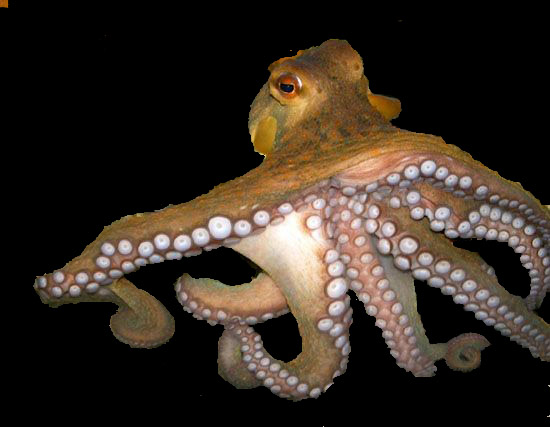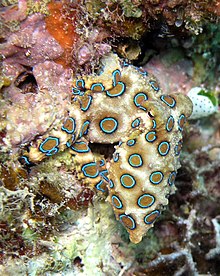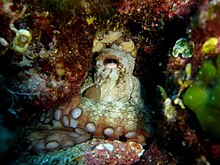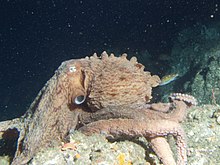| علوم جانوری در این تالار مطالب و مباحث مرتبط با علوم جانوری قرار خواهند گرفت |

05-23-2010
|
 |
کاربر خيلی فعال  
|
|
تاریخ عضویت: Jan 2010
نوشته ها: 2,007
سپاسها: : 926
875 سپاس در 242 نوشته ایشان در یکماه اخیر
|
|
 نرمتنان - معرفی اختاپوس
نرمتنان - معرفی اختاپوس
kingdom: animalia
phylum: Mollusca
class: Cephalopoda
order:Octopoda
هَشتپا یا اُختاپوس یک جانور آبزی از رده سرپایان است که در بخشهای گوناگونی از اقیانوسهای جهان، بهویژه در آبسنگهای مرجانی زندگی میکند.
۳۰۰ گونه از هشتپا شناسایی شده که این تعداد، یکسوم از تمامی گونههای سرپایان را تشکیل میدهد.
هشتپاها از زیرردهٔ نیامداران (Coleoidea)، بالاراستهٔ هشتپاشکلان (Octopodiformes) و راستهٔ هشتپایان (Octopoda) است.
ریختشناسی
هشتپاها دارای هشت بازو هستند که بر روی آنها دو ردیف کلاهک مکنده وجود دارد. بر خلاف بیشتر سرپایان، هشتپاها تقریباً هیچ اسکلت درونی ندارند و بدنشان کاملاً نرم است. آنها نه مانند ناتیلوس صدف بیرونی دارند و نه مانند سرپاور (ماهی مرکب) استخوان درونی دارند. یک منقار، شبیه به منقار طوطی، تنها قسمت سفت در بدن هشتپاها است. این منقار به هشتپا توانایی رفتن به لای شکافهای باریک بین صخرههای زیرآبی به هنگام گریختن از دست مارماهی موری و دیگر ماهیان شکارچی را میدهد.
لازم به ذکر است که اختاپوس تنها بی مهره ای می باشد که دارای هوش بالا و قدرت حل مسئله دارد بطوریکه اگر یک ماده مغذی را درون یک بطری در بسته بگذاریم قادر خواهد بود درب شیشه را باز کرده و از آن ماده تغذیه نماید!
__________________
من ندانم که کیم
من فقط میدانم
که تویی
شاه بیت غزل زندگیم...
ویرایش توسط Setare : 05-23-2010 در ساعت 09:33 PM
|
|
جای تبلیغات شما اینجا خالیست با ما تماس بگیرید
|
|

05-23-2010
|
 |
کاربر خيلی فعال  
|
|
تاریخ عضویت: Jan 2010
نوشته ها: 2,007
سپاسها: : 926
875 سپاس در 242 نوشته ایشان در یکماه اخیر
|
|

The octopus is a cephalopod of the order Octopoda. Octopuses have two eyes and four pairs of arms and like other cephalopods are bilaterally symmetric. An octopus has a hard beak, with its mouth at the center point of the arms. Most octopuses have no internal or external skeleton, allowing them to squeeze through tight places. Octopuses are highly intelligent, probably the most intelligent of all invertebrates.
The octopus inhabits many diverse regions of the ocean, especially coral reefs. For defense against predators, they hide, flee quickly, expel ink, or use color-changing camouflage. An octopus trails its eight arms behind it as it swims. All octopuses are venomous, but only the small blue-ringed octopuses are deadly to humans.[3]
In the larger sense, there are around 300 recognized octopus species, which is over one-third of the total number of known cephalopod species. The term octopus may also be used to refer only to those creatures in the genus Octopus
Biology
Octopuses are characterized by their eight arms, usually bearing suction cups. The arms of octopuses are often distinguished from the pair of feeding tentacles found in squid and cuttlefish. Both types of limbs are muscular hydrostats. Unlike most other cephalopods, the majority of octopuses – those in the suborder most commonly known, Incirrina – have almost entirely soft bodies with no internal skeleton. They have neither a protective outer shell like the nautilus, nor any vestige of an internal shell or bones, like cuttlefish or squid. A beak, similar in shape to a parrot's beak, is the only hard part of their body. This enables them to squeeze through very narrow slits between underwater rocks, which is very helpful when they are fleeing from morays or other predatory fish. The octopuses in the less familiar Cirrina suborder have two fins and an internal shell, generally reducing their ability to squeeze into small spaces.
An octopus moving between tide pools during low tide
Octopuses have a relatively short life expectancy, and some species live for as little as six months. Larger species, such as the North Pacific Giant Octopus, may live for up to five years under suitable circumstances. However, reproduction is a cause of death: males can only live for a few months after mating, and females die shortly after their eggs hatch. They neglect to eat during the (roughly) one month period spent taking care of their unhatched eggs, but they don't die of starvation. Endocrine secretions from the two optic glands are the cause of genetically-programmed death (and if these glands are surgically removed, the octopus may live many months beyond reproduction, until she finally starves).
Stauroteuthis syrtensis, a finned octopus of the suborder Cirrina
Octopuses have three hearts. Two pump blood through each of the two gills, while the third pumps blood through the body. Octopus blood contains the copper-rich protein hemocyanin for transporting oxygen. Although less efficient under normal conditions than the iron-rich hemoglobin of vertebrates, in cold conditions with low oxygen pressure, hemocyanin oxygen transportation is more efficient than hemoglobin oxygen transportation. The hemocyanin is dissolved in the plasma instead of being carried within red blood cells and gives the blood a blue color. Octopuses draw water into their mantle cavity where it passes through its gills. As mollusks, octopuses have gills that are finely divided and vascularized outgrowths of either the outer or the inner body surface.
Intelligence
Octopuses are highly intelligent, likely more so than any other order of invertebrates. The exact extent of their intelligence and learning capability is much debated among biologists, but maze and problem-solving experiments have shown that they do have both short- and long-term memory. Their short lifespans limit the amount they can ultimately learn. There has been much speculation to the effect that almost all octopus behaviors are independently learned rather than instinct-based, although this remains largely unproven. They learn almost no behaviors from their parents, with whom young octopuses have very little contact.
An octopus opening a container with a screw cap
An octopus has a highly complex nervous system, only part of which is localized in its brain. Two-thirds of an octopus's neurons are found in the nerve cords of its arms, which have a remarkable amount of autonomy. Octopus arms show a wide variety of complex reflex actions arising on at least three different levels of the nervous system. Unlike vertebrates, the complex motor skills of octopuses in their higher brain are not organized using an internal somatotopic map of its body. Some octopuses, such as the mimic octopus, will move their arms in ways that emulate the movements of other sea creatures.
In laboratory experiments, octopuses can be readily trained to distinguish between different shapes and patterns. They have been reported to practice observational learning,[10] although the validity of these findings is widely contested on a number of grounds. Octopuses have also been observed in what some have described as play: repeatedly releasing bottles or toys into a circular current in their aquariums and then catching them. Octopuses often break out of their aquariums and sometimes into others in search of food. They have even boarded fishing boats and opened holds to eat crabs.
In some countries, octopuses are on the list of experimental animals on which surgery may not be performed without anesthesia. In the UK, cephalopods such as octopuses are regarded as honorary vertebrates under the Animals (Scientific Procedures) Act 1986 and other cruelty to animals legislation, extending to them protections not normally afforded to invertebrates.
The octopus is the only invertebrate which has been conclusively shown to use tools. At least four specimens of the Veined Octopus (Amphioctopus marginatus) have been witnessed retrieving discarded coconut shells, manipulating them, and then reassembling them to use as shelter. This discovery was documented in the journal Current Biology and has also been caught on video.
Defense
Greater Blue-ringed Octopus (Hapalochlaena lunulata)
An octopus's main (primary) defense is to hide, either not to be seen at all, or not to be detected as an octopus. Octopuses have several secondary defenses (defenses they use once they have been seen by a predator). The most common secondary defense is fast escape. Other defenses include the use of ink sacs, camouflage, and autotomising limbs.
Most octopuses can eject a thick blackish ink in a large cloud to aid in escaping from predators. The main colouring agent of the ink is melanin, which is the same chemical that gives humans their hair and skin colour. This ink cloud is thought to reduce the efficiency of olfactory organs, which would aid an octopus's evasion from predators that employ smell for hunting, such as sharks. Ink clouds of some species might serve as pseudomorphs, or decoys that the predator attacks instead.
An octopus's camouflage is aided by certain specialized skin cells which can change the apparent color, opacity, and reflectiveness of the epidermis. Chromatophores contain yellow, orange, red, brown, or black pigments; most species have three of these colors, while some have two or four. Other color-changing cells are reflective iridophores, and leucophores (white). This color-changing ability can also be used to communicate with or warn other octopuses. The very venomous blue-ringed octopus becomes bright yellow with blue rings when it is provoked. Octopuses can use muscles in the skin to change the texture of their mantle in order to achieve a greater camouflage. In some species the mantle can take on the spiky appearance of seaweed, or the scraggly, bumpy texture of a rock, among other disguises. However in some species skin anatomy is limited to relatively patternless shades of one color, and limited skin texture. It is thought that octopuses that are day-active and/or live in complex habitats such as coral reefs have evolved more complex skin than their nocturnal and/or sand-dwelling relatives.
When under attack, some octopuses can perform arm autotomy, in a similar manner to the way skinks and other lizards detach their tails. The crawling arm serves as a distraction to would-be predators.
A few species, such as the Mimic Octopus, have a fourth defense mechanism. They can combine their highly flexible bodies with their color changing ability to accurately mimic other, more dangerous animals such as lionfish, sea snakes, and eels.
Reproduction
When octopuses reproduce, males use a specialized arm called a hectocotylus to insert spermatophores (packets of sperm) into the female's mantle cavity. The hectocotylus in benthic octopuses is usually the third right arm. Males die within a few months of mating. In some species, the female octopus can keep the sperm alive inside her for weeks until her eggs are mature. After they have been fertilized, the female lays about 200,000 eggs (this figure dramatically varies between families, genera, species and also individuals). The female hangs these eggs in strings from the ceiling of her lair, or individually attaches them to the substrate depending on the species. The female cares for the eggs, guarding them against predators, and gently blowing currents of water over them so that they get enough oxygen. The female does not hunt during the roughly one-month period spent taking care of the unhatched eggs and may ingest some of her own arms for sustenance. At around the time the eggs hatch, the mother leaves the lair and is too weak to defend herself from predators like cod, often succumbing to their attacks. The young larval octopuses spend a period of time drifting in clouds of plankton, where they feed on copepods, larval crabs and larval starfish until they are ready to descend to the ocean bottom, where the cycle repeats. This is a dangerous time for the larval octopuses; in the plankton cloud they are vulnerable to plankton eaters. In some deeper dwelling species, the young do not go through this period.
Sensation
Eye of Octopus vulgaris
Octopuses have keen eyesight. Octopuses, like other cephalopods, can distinguish the polarization of light. Color vision appears to vary from species to species, being present in Octopus aegina but absent in Octopus vulgaris. Attached to the brain are two special organs, called statocysts, that allow the octopus to sense the orientation of its body relative to horizontal. An autonomic response keeps the octopus's eyes oriented so that the pupil slit is always horizontal.
Octopuses also have an excellent sense of touch. An octopus's suction cups are equipped with chemoreceptors so that the octopus can taste what it is touching. The arms contain tension sensors so that the octopus knows whether its arms are stretched out. However, the octopus has a very poor proprioceptive sense. The tension receptors are not sufficient for the octopus brain to determine the position of the octopus's body or arms. (It is not clear that the octopus brain would be capable of processing the large amount of information that this would require; the flexibility of an octopus's arms is much greater than that of the limbs of vertebrates, which devote large areas of cerebral cortex to the processing of proprioceptive inputs.) As a result, the octopus does not possess stereognosis; that is, it does not form a mental image of the overall shape of the object it is handling. It can detect local texture variations, but cannot integrate the information into a larger picture.
The neurological autonomy of the arms means that the octopus has great difficulty learning about the detailed effects of its motions. The brain may issue a high-level command to the arms, but the nerve cords in the arms execute the details. There is no neurological path for the brain to receive feedback about just how its command was executed by the arms; the only way it knows just what motions were made is by observing the arms visually.
Octopuses appear to have limited hearing.
Octopuses swim headfirst, with arms trailing behind
Locomotion
Octopuses move about by crawling or swimming. Their main means of slow travel is crawling, with some swimming. Jet propulsion is their fastest means of locomotion, followed by swimming and walking.
They crawl by walking on their arms, usually on many at once, on both solid and soft surfaces, while supported in water. In 2005 it was reported that some octopuses (Adopus aculeatus and Amphioctopus marginatus under current taxonomy) can walk on two arms, while at the same time resembling plant matter.[24] This form of locomotion allows these octopuses to move quickly away from a potential predator while possibly not triggering that predator's search image for octopus (food).
Octopuses swim by expelling a jet of water from a contractile mantle, and aiming it via a muscular siphon.
Size
See also: Cephalopod size
An adult North Pacific Giant Octopus, Enteroctopus dofleini
The North Pacific Giant Octopus, Enteroctopus dofleini, is often cited as the largest octopus species. Adults usually weigh around 15 kg (33 lb), with an arm span of up to 4.3 m (14 ft). The largest specimen of this species to be scientifically documented was an animal with a live mass of 71 kg (156.5 lb). The alternative contender is the Seven-arm Octopus, Haliphron atlanticus, based on a 61 kg (134 lb) carcass estimated to have a live mass of 75 kg (165 lb). However, there are a number of questionable size records that would suggest E. dofleini is the largest of all octopus species by a considerable margin; one such record is of a specimen weighing 272 kg (600 lb) and having an arm span of 9 m (30 ft).
__________________
من ندانم که کیم
من فقط میدانم
که تویی
شاه بیت غزل زندگیم...
ویرایش توسط Setare : 05-23-2010 در ساعت 09:41 PM
|

05-23-2010
|
 |
کاربر خيلی فعال  
|
|
تاریخ عضویت: Jan 2010
نوشته ها: 2,007
سپاسها: : 926
875 سپاس در 242 نوشته ایشان در یکماه اخیر
|
|
ویدئو زیر گویا بخشی از زندگی و قدرت حل مسئله این جانور زیبا می باشد:
نمایش فیلم
__________________
من ندانم که کیم
من فقط میدانم
که تویی
شاه بیت غزل زندگیم...
ویرایش توسط Setare : 05-23-2010 در ساعت 09:38 PM
|
|
کاربران در حال دیدن موضوع: 1 نفر (0 عضو و 1 مهمان)
|
|
|
 مجوز های ارسال و ویرایش
مجوز های ارسال و ویرایش
|
شما نمیتوانید موضوع جدیدی ارسال کنید
شما امکان ارسال پاسخ را ندارید
شما نمیتوانید فایل پیوست در پست خود ضمیمه کنید
شما نمیتوانید پست های خود را ویرایش کنید
اچ تی ام ال غیر فعال می باشد
|
|
|
اکنون ساعت 02:15 AM برپایه ساعت جهانی (GMT - گرینویچ) +3.5 می باشد.
|




















 حالت خطی
حالت خطی

